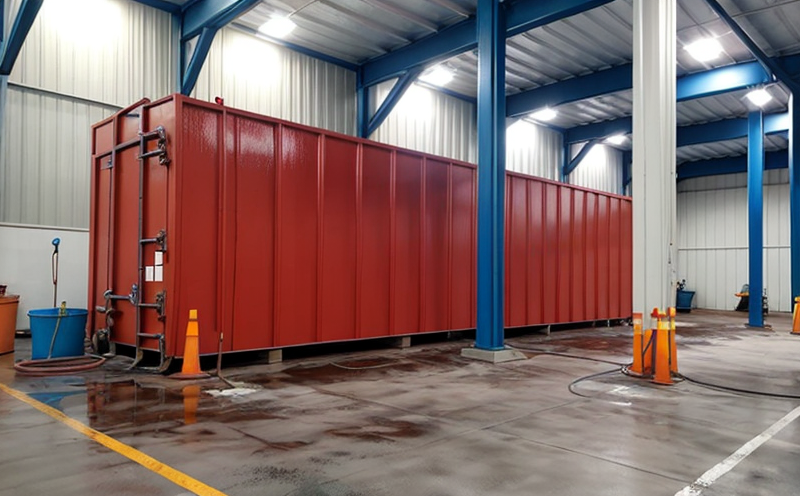DIN 53167 Water Resistance Testing of Coated Surfaces
The DIN 53167 test method is a standard procedure for assessing the water resistance properties of coated surfaces. This test plays a crucial role in ensuring that coatings applied to various industrial components and structures can withstand environmental exposure without degradation, particularly in humid or wet conditions.
Water resistance is critical for many applications across diverse sectors including automotive, aerospace, marine, construction, and general manufacturing industries. The test method provides a standardized approach to evaluate the performance of coatings under defined water immersion conditions. This ensures that the coated surfaces meet specific quality and durability requirements set by industry standards and customer expectations.
The DIN 53167 test involves immersing the specimen in water for a specified duration, followed by drying. The coating is then visually inspected to assess any changes such as blistering, cracking, or loss of adhesion. This method allows for consistent evaluation across different materials and coatings, ensuring that they meet quality benchmarks.
The standard specifies detailed procedures including the preparation of specimens, immersion conditions (temperature, duration), drying protocols, and visual inspection criteria. Compliance with DIN 53167 is essential for industries relying on high-quality surface protection to extend the life span of their products. This test not only aids in quality control but also helps in selecting appropriate coatings that meet specific performance requirements.
The reliability of coatings tested using this method can significantly impact product durability and customer satisfaction. By ensuring adherence to DIN 53167, manufacturers can enhance the credibility and longevity of their products, thereby building a strong reputation for reliability and quality.
Understanding the intricacies of the test is crucial for those involved in coating development, production, and quality assurance. Familiarity with this standard allows stakeholders to make informed decisions about material selection and process optimization, ensuring that final products meet stringent performance criteria.
Why Choose This Test
The DIN 53167 test is chosen for its precision in evaluating water resistance properties of coated surfaces. It provides a standardized approach that ensures consistent results, which are essential for quality assurance and compliance with industry standards.
This test method is particularly advantageous because it allows manufacturers to assess the performance of their coatings under controlled conditions before deployment in real-world applications. By identifying potential issues early on, companies can improve product reliability and extend service life.
Choosing DIN 53167 water resistance testing offers several key benefits:
- Ensures compliance with international standards
- Promotes consistent quality across production batches
- Aids in material selection by identifying optimal coatings for specific applications
- Enhances product durability and customer satisfaction
- Supports continuous improvement through data-driven insights
- Facilitates regulatory compliance, reducing the risk of non-conformance penalties
The detailed nature of this test method also allows for thorough evaluation, ensuring that coatings perform reliably under challenging conditions. This is particularly important in sectors where product integrity and durability are critical.
In summary, selecting DIN 53167 water resistance testing not only enhances the quality of products but also provides a competitive edge by ensuring consistent performance across batches and meeting stringent regulatory requirements.
Customer Impact and Satisfaction
The impact of DIN 53167 water resistance testing extends beyond the manufacturing process to significantly influence customer satisfaction. By ensuring that coated surfaces meet stringent performance criteria, manufacturers can deliver products with enhanced durability and reliability.
Customers benefit from products that are less prone to degradation under environmental conditions, leading to longer product life spans. This reduces maintenance costs and enhances overall customer experience by providing more robust and dependable solutions.
The consistent quality ensured by this test method also builds trust between manufacturers and their customers. Reliable performance of coated surfaces can lead to repeat business and positive word-of-mouth recommendations, further strengthening market position.
Moreover, compliance with DIN 53167 aligns product offerings with global industry standards, making them more attractive to international markets where stringent quality benchmarks are required.
In summary, the use of DIN 53167 water resistance testing not only enhances product performance but also contributes to higher customer satisfaction and loyalty. This ultimately translates into increased market share and sustained competitive advantage in the industrial sector.
Use Cases and Application Examples
The DIN 53167 water resistance test finds extensive application across various sectors where coated surfaces are exposed to moisture. Some key use cases include:
- Aerospace Industry: Coatings used on aircraft components must withstand humid environments, especially during takeoff and landing cycles.
- Marine Industry: Protective coatings for ships and marine structures need to resist saltwater corrosion.
- Automotive Sector: Paints and coatings on vehicle bodies should endure rain and humidity without degradation.
- Construction Industry: Exterior building materials often require water-resistant finishes to protect against weather elements.
In each of these sectors, the test method provides a reliable means to assess coating performance under controlled conditions. This ensures that coatings meet specific durability requirements necessary for their intended use.
The real-world application examples highlight how DIN 53167 contributes to the success of industrial products by ensuring consistent quality and reliability across different environments. For instance, in the aerospace industry, a coating that passes this test can be expected to perform reliably under humid conditions, thus enhancing the overall safety and performance of aircraft components.
Similarly, coatings used on marine structures should withstand saltwater corrosion effectively, making DIN 53167 testing critical for ensuring product longevity. In summary, the use cases underscore the importance of this test method in various industrial sectors, ensuring that coated surfaces meet stringent durability requirements necessary for their respective applications.





